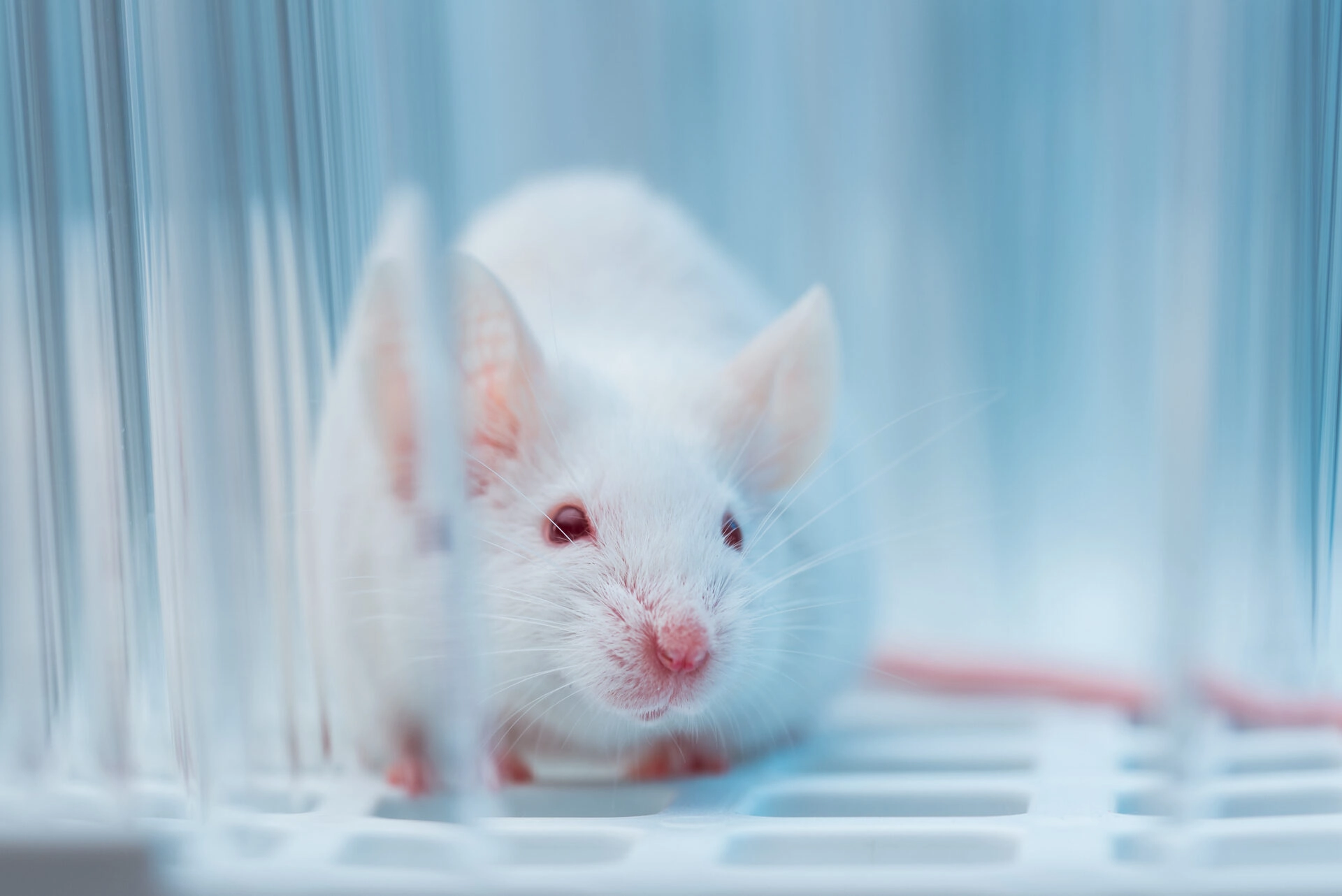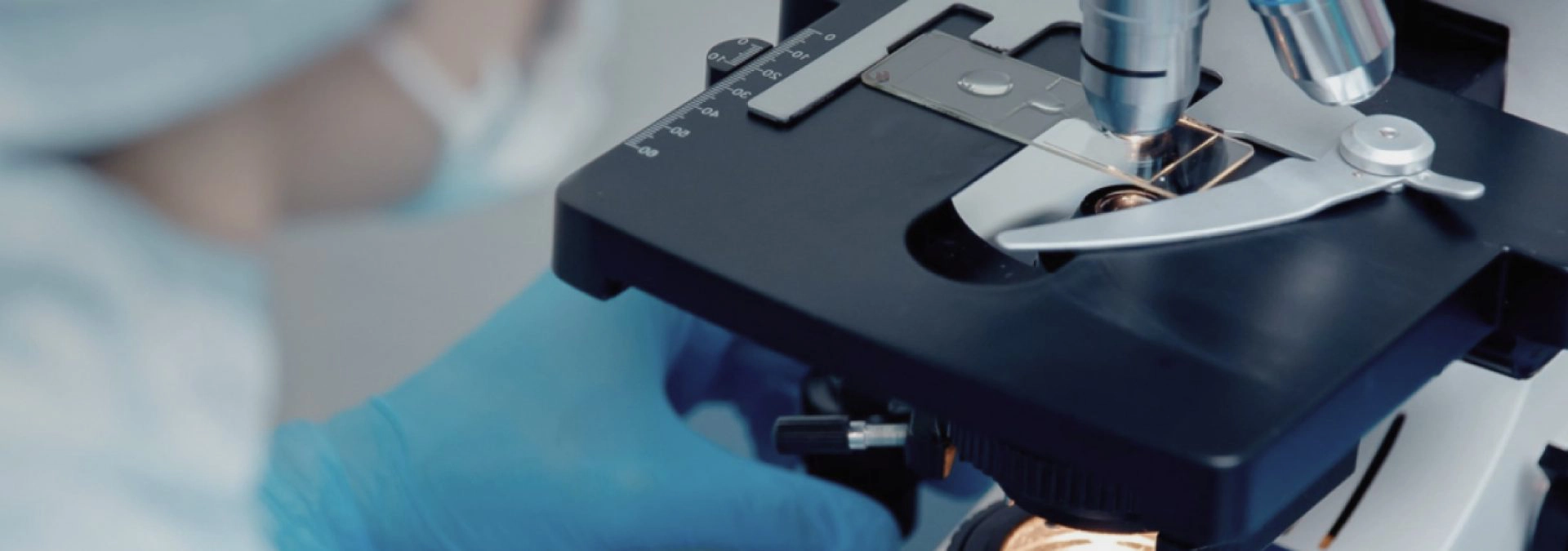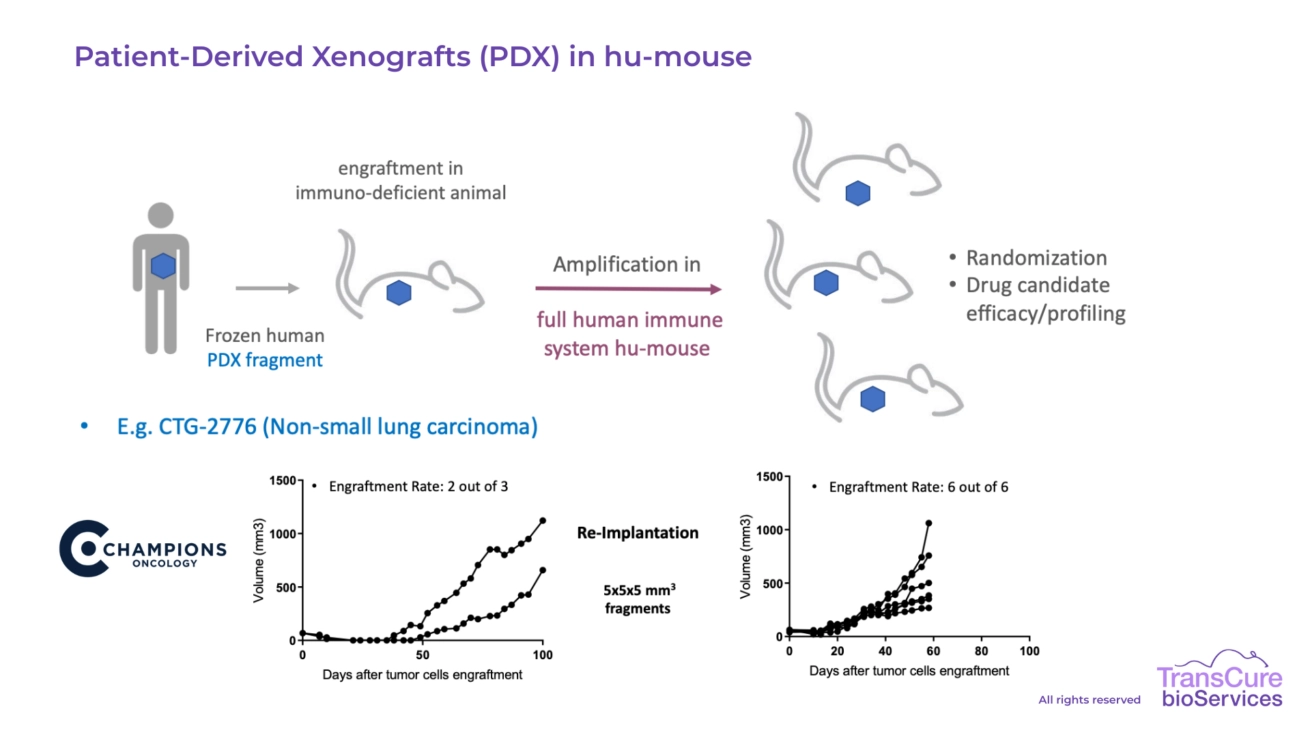
Humanized Mice with PDX Tumor Models
Humanized Immune System Mouse Model engrafted with Human PDX
Contact usHumanized Immune System mouse models engrafted with patient-derived xenografts (PDX) offer a promising approach for oncology research, providing a better understanding of human tumors and facilitating the development of personalized treatments.
The engraftment of PDX fragments into humanized mice, allows for the presence of human tumor tissue, partial stromal elements and a complete human immune system in CD34+ humanized mice, enabling the study of tumor behavior and response in a setting that closely mirrors the clinical reality.
Main characteristics
-
PDX Engraftment
The process begins with the engraftment of a thawed or fresh human PDX tumor fragment into non-humanized immunodeficient mice to allow initial tumor establishment. Once expanded, the tumor is then transplanted into CD34+ humanized mice, where it grows in the context of a fully functional human immune system. This enables subsequent randomization, therapeutic intervention with candidate drugs, and comprehensive efficacy evaluation and immune profiling, all within a physiologically relevant, human-specific tumor–immune microenvironment.
-
Tailor Made Models
At TransCure BioServices, we specialize in the development of tailored humanized mouse models to meet the specific needs of your research program. Whether it’s selecting the appropriate tumor type, immune profile, administration route, or optimizing readouts, our expert team works closely with you to design and execute customized in vivo studies. We can either work with PDX material provided by the study sponsor or utilize well-characterized PDX models sourced through our trusted collaborators.
-
TILs Characterization
We have developed robust protocols for tumor dissociation to enable detailed TIL (tumor-infiltrating lymphocyte) profiling by flow cytometry. Our dedicated flow cytometry platform designs custom panels tailored to your specific needs, and our expert team is available to advise on the most appropriate strategies for your study goals. Additionally, we offer TIL analysis by immunohistochemistry (IHC) to provide spatial insights into immune cell localization within the tumor, complementing cellular data with valuable tissue context.
-
Tumor Volume Measurement
For solid tumor PDX models, tumor growth and treatment response are primarily assessed through volume measurements using calipers, offering a straightforward and reliable method for monitoring progression. If additional resolution is required, in vivo imaging can be incorporated to provide non-invasive, real-time visualization of tumor dynamics, enhancing the depth and precision of the evaluation.
-
PK/PD analysis
Throughout the study, blood samples can be collected at multiple time points and used for PK/PD analysis. We offer in-house capabilities for flow cytometry and CBA-based cytokine profiling, providing real-time insights into drug activity and immune responses. Alternatively, we can process and store plasma or serum and ship samples back to your laboratory for further analysis, offering maximum flexibility to suit your workflow and analytical preferences.
Applications
The right mouse model for your research experimentation
-
CD34+ humanized Immune System Mouse Model
Evaluate both the efficacy and immunotoxicity of your lead candidate using a fully reconstituted human immune system, generated by engrafting CD34+ hematopoietic stem cells into highly immunodeficient mice.
See the mouse model
Contact us to have more information about this mouse model
Contact usKnow everything about the CD34+ humanized mouse
-
How do you generate humanized mice?
Humanized mice are generated by engraftment of CD34+ haematopoietic stem cells from human cord blood in immunodeficient mouse strain after a chemoablation treatment. No irradition is performed to avoid anemia and therefore get more robust and stable humanized mice. -
What type of mouse strain can be humanized?
With more than 12 years of expertise, TransCure can humanize many different mouse strains, all have in common to be highly immunodeficient mouse models: NCG, NOG, NOG-EXL… Our team can guide you on the best model to select based on your mechanism of Action. Please note that humanized NCG are prepared in advance to speed up the process. -
What is the advantage of the boost by comparison to transgenic mouse models?
To achieve a more balanced and representative differentiation of dendritic cells, myeloid cells, and NK cells, we have developed an optimized boosting protocol that enhances these populations without overstimulating the T cell compartment. This is accomplished through hydrodynamic injection of plasmids encoding key human cytokines—IL-3, IL-4, IL-15, GM-CSF, and FLT3L - promoting targeted immune lineage expansion while preserving immune system homeostasis. -
How many animals do you recommend per arm ?
For PDX studies, starting with a minimum of 8 mice per group provides statistically robust and reliable data. This group size ensures sufficient power to detect meaningful differences while maintaining study efficiency and ethical standards. -
CDX vs PDX
While PDX models offer valuable clinical relevance, they also come with certain limitations. Establishing and maintaining PDX models can be time-consuming, technically demanding, and less scalable compared to cell-derived xenograft (CDX) models in humanized mice. In addition, repeated passaging of PDX tumors may lead to genetic and phenotypic drift, potentially reducing their fidelity to the original patient tumor over time. For these reasons, CDX models often serve as an essential first step - allowing for rapid screening, immune profiling, and therapeutic evaluation - before transitioning to more complex and resource-intensive PDX studies.
You have more questions ?
If you have further questions or would like to discuss how our PDX Tumor models can be tailored to your specific research needs, our scientific team is here to help. We’re committed to providing clear, responsive support and working closely with you to design studies that align with your objectives. Don’t hesitate to reach out - we’re always happy to share our expertise and explore solutions together.
Contact us
